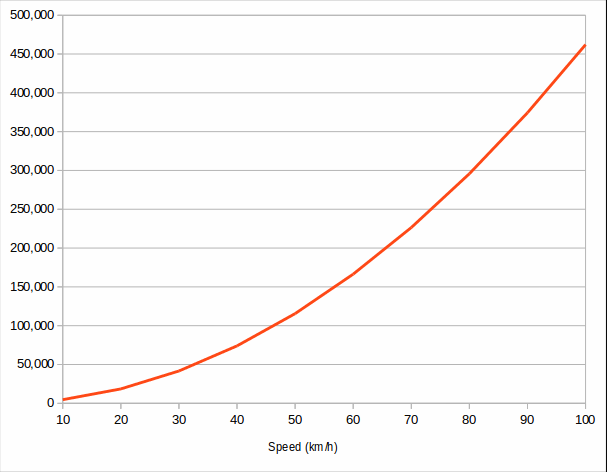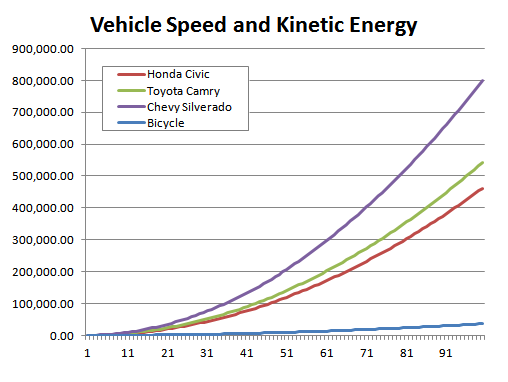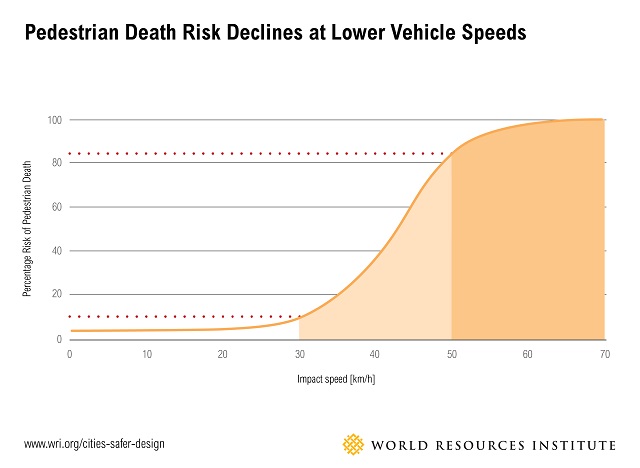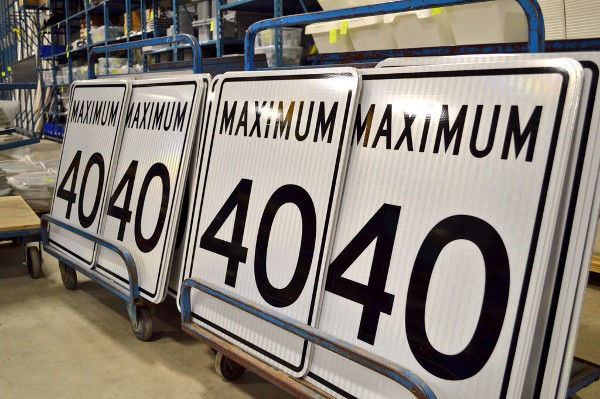The short answer is: because physics. For the longer answer, we need to review some classical mechanics you may remember from high school.
By Ryan McGreal
Published April 18, 2016
One of the core principles of the Vision Zero approach to traffic safety is that on streets where people on foot cross paths with people in automobiles, it is imperative that the automobiles maintain a speed low enough to prevent death or serious injury in the case of a collision. This is generally taken to mean maintaining vehicle speeds at or below 30 km/h.
Some readers may wonder why this particular speed is so often recommended - and adopted - by cities committing to Vision Zero. The short answer is: because physics.
For the longer answer, we need to review some classical mechanics that you might remember from high school.
The kinetic energy of a moving object is the energy the object possesses as a result of being in motion. Obviously, an object sitting at rest does not have any kinetic energy, but once it starts moving, it has kinetic energy - and when it is moving faster, its kinetic energy goes up.
But there is something very important about the relationship between an object's speed and its kinetic energy. It is not a linear relationship, in which a certain increase in speed produces an equivalent increase in energy. Instead, it is a quadratic relationship: if you double an object's speed, its kinetic energy doesn't double, it roughly quadruples. Likewise, if you quadruple its speed, its kinetic energy increases roughly 16-fold.
The formula to calculate kinetic energy is as follows:
Kinetic energy (Joules) = 1/2 X mass (kg) X velocity (m/s) squared
Let's apply the formula with a real vehicle at various speeds. My car is a 2012 Honda Civic sedan, which has a curb weight of 1,198 kg (2,641 lb). The following table calculates its kinetic energy at various speeds between 10 km/h and 100 km/h.
| Curb Weight | Speed | Kinetic Energy (J) | ||
|---|---|---|---|---|
| (lbs) | (kg) | (km/h) | (m/s) | |
| 2,641 | 1,198 | 10 | 2.8 | 4,622 |
| 2,641 | 1,198 | 20 | 5.6 | 18,487 |
| 2,641 | 1,198 | 30 | 8.3 | 41,595 |
| 2,641 | 1,198 | 40 | 11.1 | 73,947 |
| 2,641 | 1,198 | 50 | 13.9 | 115,542 |
| 2,641 | 1,198 | 60 | 16.7 | 166,380 |
| 2,641 | 1,198 | 70 | 19.4 | 226,462 |
| 2,641 | 1,198 | 80 | 22.2 | 295,787 |
| 2,641 | 1,198 | 90 | 25.0 | 374,355 |
| 2,641 | 1,198 | 100 | 27.8 | 462,167 |
Here's how that looks when you plot the kinetic energy (Y axis) against vehicle speed (X axis):

Chart: Kinetic energy by speed, Honda Civic
As you can see, the kinetic energy increases in a curve, not a straight line. That is what is meant by calling kinetic energy a quadratic formula rather than a linear formula.
Another important thing to note is that heavier vehicles increase kinetic energy even more dramatically. The following table calculates kinetic energy at the same speeds for a Toyota Camry, a popular mid-sized sedan.
| Curb Weight | Speed | Kinetic Energy (J) | ||
|---|---|---|---|---|
| (lbs) | (kg) | (km/h) | (m/s) | |
| 3,240 | 1,470 | 10 | 2.8 | 5,670 |
| 3,240 | 1,470 | 20 | 5.6 | 22,680 |
| 3,240 | 1,470 | 30 | 8.3 | 51,029 |
| 3,240 | 1,470 | 40 | 11.1 | 90,718 |
| 3,240 | 1,470 | 50 | 13.9 | 141,748 |
| 3,240 | 1,470 | 60 | 16.7 | 204,116 |
| 3,240 | 1,470 | 70 | 19.4 | 277,825 |
| 3,240 | 1,470 | 80 | 22.2 | 362,874 |
| 3,240 | 1,470 | 90 | 25.0 | 459,262 |
| 3,240 | 1,470 | 100 | 27.8 | 566,990 |
And the following table does the same calculations for a Chevrolet Silverado, a popular full-size pickup truck.
| Curb Weight | Speed | Kinetic Energy (J) | ||
|---|---|---|---|---|
| (lbs) | (kg) | (km/h) | (m/s) | |
| 4,567 | 2,072 | 10 | 2.8 | 7,992 |
| 4,567 | 2,072 | 20 | 5.6 | 31,968 |
| 4,567 | 2,072 | 30 | 8.3 | 71,929 |
| 4,567 | 2,072 | 40 | 11.1 | 127,874 |
| 4,567 | 2,072 | 50 | 13.9 | 199,803 |
| 4,567 | 2,072 | 60 | 16.7 | 287,716 |
| 4,567 | 2,072 | 70 | 19.4 | 391,613 |
| 4,567 | 2,072 | 80 | 22.2 | 511,495 |
| 4,567 | 2,072 | 90 | 25.0 | 647,361 |
| 4,567 | 2,072 | 100 | 27.8 | 799,211 |
As you can see, the sheer physics involved makes the risk outcome for pedestrians pretty inevitable. At vehicle speeds below 30 km/h, the risk of fatality for a pedestrian struck by a vehicle is very close to zero. As speeds increase, fatality risk increases quadratically according to the rising kinetic energy of the faster-moving vehicle.
I should note here that the vehicle's mass also contributes significantly to its kinetic energy. The following chart shows the kinetic energy at various speeds for all three profiled vehicles, with the addition of the curve for a person on a bicycle for comparison:

Chart: Vehicle Speed and Kinetic Energy
That Silverado has 1.7 times the mass of the Civic. At any given speed, it also has 1.7 times the kinetic energy.
The following chart from World Resources Institute shows how that risk of fatality changes as speed goes up.

Chart: Pedestrian death risk by vehicle speed
This is clearly and abundantly documented in road safety research. The classic source is a 1997 UK Department of Transportation Study titled Killing Speed and Saving Lives, which found that pedestrian fatality risk rose from just 5 percent when the vehicle was going at 32 km/h (20 mph) to 45 percent when the vehicle was going at 48 km/h (30 mph) and a staggering 85 percent when the vehicle was going 64 km/h (40 mph).
Likewise, a 1999 research review by the United States Department of Transportation National Highway Traffic Safety Administration surveys a wide sweep of traffic studies and concludes:
Reductions in vehicle speeds can have a very significant influence on pedestrian crashes and injuries. Pedestrians suffer much more serious injuries when struck by high-speed vehicles than when struck by vehicles going more slowly. Also, many pedestrian crashes would be prevented entirely had the vehicles been traveling more slowly, since driver and pedestrian would have had more time to perceive the risk and react.
Incidentally, the report also notes that speed limit reduction is more successful when accompanied by physical changes to the street to induce traffic calming:
The accumulated weight of evidence from studies of traffic calming is that pedestrian injuries and total, or motor vehicle, crashes and injuries are closely related. Traffic calming which reduces motor vehicle crashes and injuries also reduces pedestrian injuries and severities.
So it is particularly distressing that the City of Hamilton has nominally committed to Vision Zero but refuses to commit to the 30 km/h speed limit that classical mechanics tells us we need to maintain to make our streets truly safe.
Instead, we are compromising with a more modest reduction to 40 km/h - and only in selected locations - on the shaky assumption that it will be more politically palatable to people who are inclined to favour their convenience over other people's safety.

40 km/h speed limit signs ready to be deployed (Image Credit: City of Hamilton)
The basic problem with this half-measure is that there is no arguing with the laws of physics.
If you want to play around with the Kinetic Energy formula, the following form will calculate kinetic energy based on the values in the input boxes above it.
| Weight (lb) | |
|---|---|
| Weight (kg) | |
| Speed (km/h) | |
| Speed (m/s) | |
| Kinetic Energy: | 41595 J |
By jason (registered) | Posted April 18, 2016 at 20:50:48
there is zero reason why every residential side street in Hamilton shouldn't be 30km. And 40 is fine for most minor arterial roads like Wilson, Locke, Dundurn, Kenilworth etc..... The city's addiction to speed needs to end.
By jim (anonymous) | Posted April 19, 2016 at 04:56:30 in reply to Comment 117732
By orangemike (registered) | Posted April 19, 2016 at 17:49:21 in reply to Comment 117736
there is no broad public opposition to this. there is whining and sobbing from car culture cul de saccers like jim graham and socre and the other members of the brain trust that is "the hamiltonian" comment section.
By a reach too far (anonymous) | Posted April 19, 2016 at 18:19:31 in reply to Comment 117765
the car culture is a broad representation of Hamilton. Until that is accepted it cant be fixed
By orangemike (registered) | Posted April 20, 2016 at 18:11:30 in reply to Comment 117766
"Until that is accepted it cant be fixed" many dont and wont accept it and are fixing it as we speak. thank you to them.
By a reach too far (anonymous) | Posted April 20, 2016 at 19:09:21 in reply to Comment 117793
No they really aren't
By Translation (anonymous) | Posted April 19, 2016 at 07:33:44 in reply to Comment 117736
"the somewhat thorny issue of broad public opposition to such nonsense" = Entitled Hamilton Drivers that have had their every whim catered to for 60 years.
By NIMBY (anonymous) | Posted April 18, 2016 at 21:41:05 in reply to Comment 117732
By jason (registered) | Posted April 19, 2016 at 06:59:54 in reply to Comment 117733
Oh I think 30k city-wide would be fantastic. But this isn't what we call a progressive town. 40 on those larger streets would be a vast improvement over the 50-60 that is common. But if anyone needs signatures to go 30 on such streets, I'll sign.
By NIMBY (anonymous) | Posted April 19, 2016 at 11:49:42 in reply to Comment 117737
By KevinLove (registered) | Posted April 18, 2016 at 21:48:12
It is very informative to put in the table the values for my bicycle, a Pashley Roadster Sovereign. The result for a 20 kg bicycle at 20 km/hr makes it quite clear why cyclists have already achieved Vision Zero.
The Dutch "Sustainable Safety" model does not rely upon speed limits, but upon engineering to provide safety. It is useful to see Mark Wagonbuur's recent video essay on Utrecht, a city about the same size as Hamilton. Please be sure to watch the video at the end. Not once are car speed limits mentioned. But look at the infrastructure!
Every piece of that infrastructure can be easily built in Hamilton. Utrecht did it. We can too!
By Willem (anonymous) | Posted April 19, 2016 at 00:19:47
This is sound, but you might want to make the explicit connection between kinetic energy and damage/injury/chance of death.
By Surbanite (anonymous) | Posted April 19, 2016 at 07:32:56
I'm with Willem on this. Is there any data on what kinetic energy the body can withstand? Or does that question even make sense? Presumably, this would be quite different depending on the age of the pedestrian but along the lines of the design theory of Ages 8 to 80, perhaps there is data for those 2 age groups which would help with the thorny issue of the broad public perception, 30 km/h is nonsense ?
By LASTYEAR (anonymous) | Posted April 19, 2016 at 15:46:04 in reply to Comment 117738
At least three of the pedestrians killed last year were hit a speeds of less than 30kph.
By KevinLove (registered) | Posted April 19, 2016 at 19:21:15 in reply to Comment 117757
If you are being run over by a vehicle that weighs over 4,500 lbs, you are going to get crushed. Vehicle speed is irrelevant.
That is why it is important to have 100% segregation of cars and bikes.
By ryanssockpuppet (anonymous) | Posted April 20, 2016 at 08:02:12 in reply to Comment 117768
By the lunatics are in the comments (anonymous) | Posted April 20, 2016 at 08:08:31 in reply to Comment 117780
no one is forcing you to come here and read (or post). if you truly thought none of this mattered you would ignore it. but I guess you realize that the truths and realities discussed here are barelling towards you and threatening your cushy self-centred life... sorry old man, the guard is changing.
By ryanssockpuppet (anonymous) | Posted April 21, 2016 at 07:55:41 in reply to Comment 117782
By Selma (anonymous) | Posted April 19, 2016 at 20:27:29 in reply to Comment 117768
By Map (anonymous) | Posted April 19, 2016 at 09:05:20
Is there a map available showing streets by speed limit in Hamilton?
I looked on the City website but couldn't find anything (a common occurrence).
I wish I could hack Google maps better.
By Anonymous Adam (anonymous) | Posted April 19, 2016 at 16:00:19
I am pretty sure that getting hit by a car at 20km is around 90% chance of fatality. 30km 95% 40km 96% and so on...., I know I made this up, but it shouldn't take a genius to figure out getting hit by a car is near fatal nearly all the time, so trying to prove a point to lower speed limits only matters if you remove the cars from the road or segregate them from anything else that could use the road.
Its like a DOT helmet, yeah it can withstand such and such an impact, but you will probably be close to death if you get hit that hard, a higher rating helmet only gives you that extra percent of survival...if you get hit, you are in trouble regardless
You must be logged in to comment.
There are no upcoming events right now.
Why not post one?